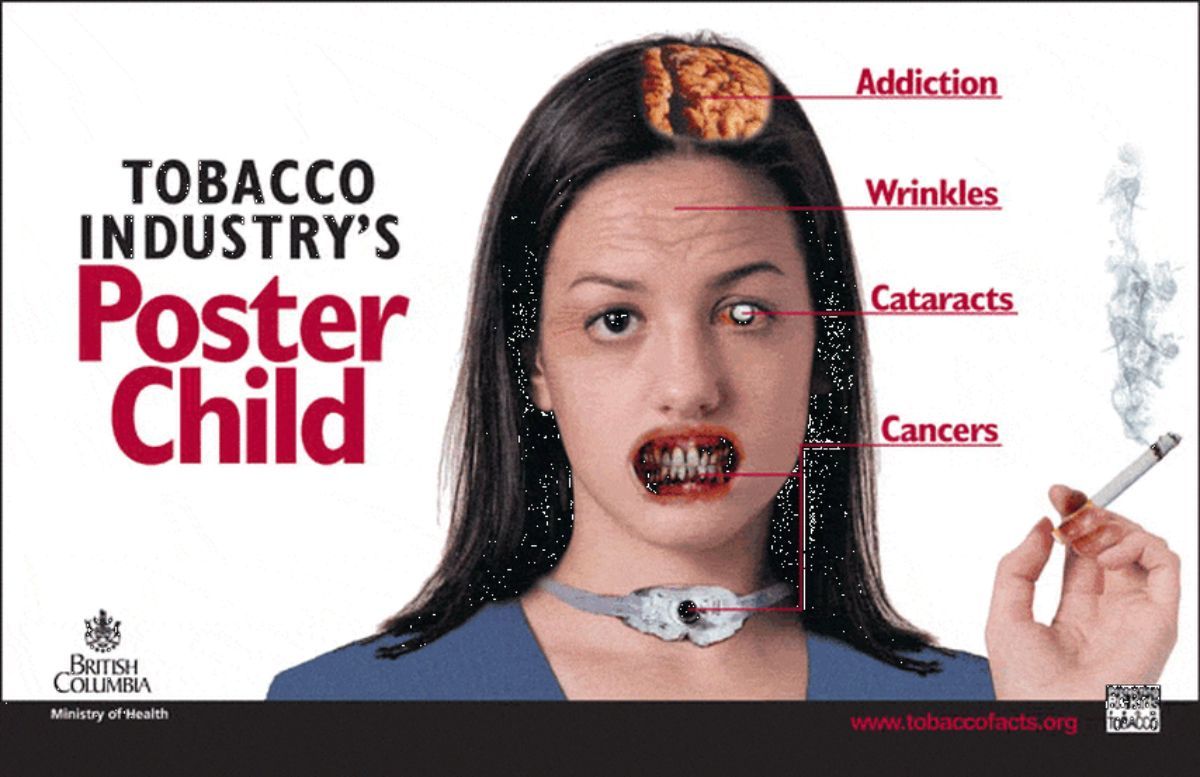U.S., Canada Gang Up on Cigarettes

Health warnings and changing social standards have reduced cigarette smoking to something routinely practiced by a small band of determined smokers who are unwilling or unable to kick their nicotine addiction, and by teens who take up the habit despite warnings.
Public health officials are always looking for ways to reach those who still put burning sticks of tobacco in their mouths.
Canada, which was the first country to require health warnings on cigarette packages, will soon require graphic warnings to be printed on the cigarettes themselves, not just the packages.
The U.S., meanwhile, is reported to be working on a plan to reduce the amount of nicotine allowed in each cigarette. Since it’s the nicotine that’s addictive, the hope is that this will make it a little easier for smokers to quit.
“Poison in every puff”
Canada is still working out some of the details but it looks like “Poison in every puff” is the leading candidate for the first slogan to be printed on cigarettes sold there.
It was two decades ago that Canada introduced printed warnings on cigarette packages but the government fears that, over time, those warnings have lost their impact.
“We need to address the concern that these messages may have lost their novelty, and to an extent we worry that they may have lost their impact as well,” the minister of mental health and addictions, Carolyn Bennett, said at a news conference. It will probably be mid-2023 before the warnings actually start appearing.worked out.
Part of the motivation, Bennett said, is to reach people who now bum smokes from friends and haven’t yet formed the habit of buying their own.
“Adding health warnings on individual tobacco products will help ensure that these essential messages reach people including the youth, who often access cigarettes one at a time in social situations, sidestepping the information printed on a package,” she said.
Less nicotine
In the U.S., the Biden administration wants to require tobacco companies to reduce the nicotine in all cigarettes to minimally or nonaddictive levels, according to a Wall Street Journal report.
The policy is expected to be announced this week but isn’t like to take effect for several years. The U.S. Food and Drug Administration will have to write the regulation, invite public comments and then work out a final version.
If the tobacco companies sue, which is likely, implementation could be delayed for several years.
The rule would be the biggest move by the U.S. government to limit smoking since 1998, when a landmark legal settlement required tobacco companies to pay more than $200 billion to help states pay for healthcare.
The companies also agreed to a number of marketing restrictions, including a ban on free product samples and advertising on billboards.
It’s natural
Nicotine occurs naturally in tobacco. Like a lot of things that aren’t good for us, it has a positive short-term effect. It perks people up, helps them concentrate and is something of a mood enhancer.
Nicotine doesn’t cause heart disease, lung cancer or other dread diseases. It’s the other chemical components of tobacco that do that, but nicotine is the hook that keeps smokers lighting up despite the health hazards.
Cigarettes are blamed for about 480,000 deaths per year in the United States, about 39,000 in Canada. Secondhand smoke is implicated in the deaths of family members and coworkers and is suspected of contributing to low birth weight and sudden infant death syndrome.
Just how tobacco companies would reduce the amount of nicotine in their products isn’t clear. They could use a different mixture of tobacco leaves, since some types have more nicotine than others, and they could strip out some of the nicotine in the manufacturing process.
It’s also possible that genetic engineering could be used to create a tobacco plant that contains only a trace of nicotine.
The hope is that lower nicotine content would make cigarettes less addictive – making it easier for teens to avoid becoming hooked and easier for longtime smokers to quit.
